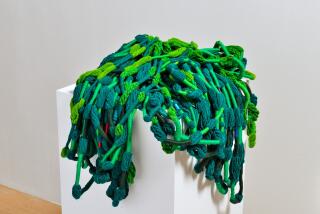Pieced from the fabric of their lives
NEW YORK — The Whitney Museum’s “Quilts of Gee’s Bend,” a collection of 60-odd quilts from a remote corner of Alabama, has everything going for it: fantastic art, profound humanity and a spectacular installation.
The quilts, created by four generations of African American women in a rural community called Gee’s Bend, overwhelm the eye with startling color and bold, idiosyncratic design. Some are elaborate constructions of floral patterns, as if the maker had disassembled a garden into tiny scraps and then whimsically reshuffled them.
The vast majority, however, are muscular arrangements of fabric in big swaths: thick bars of midnight blue and cream, stripes of yellow corduroy against an earth-brown background; all the warm, weathered hues and worn textures disposed in luminous asymmetries.
“I like big pieces and long strips,” one of the women, Annie Mae Young, says in an oral history compiled for the catalog. “However I get them, that’s how I used them. I work it out, study the way to make it, get it right, kind of like working a puzzle.”
According to the canonical interpretations of Western art, abstraction grew out of myth, psychology and historical imperative. But these quilts, made by poor women in the isolation of their southern Alabama enclave, rival the best of what modernist painting has to offer -- without the pretentious theoretical superstructure.
Some of the quilts will remind you of works by Mark Rothko, Barnett Newman and Frank Stella, but in some ways they’re better. Created under adverse circumstances by women using whatever came to hand -- faded, patched-up jeans, canvas work shirts, worn-out dresses -- to keep their families warm, the quilts have a human overlay that immeasurably enhances their power to move us.
Gee’s Bend, with a population of about 700, is 30 miles southwest of Selma at a bend in the Alabama River. For most of the 20th century, it was nearly inaccessible, and the link to the past is consequently strong: The vast majority of the townspeople are descended from slaves who worked at one plantation. The area has always been poor: Photographs of the town from the 1930s, when the earliest of the quilts in the exhibit were made, describe lives led in two-room log cabins.
Quilts were the one note of exuberance during the Depression in Gee’s Bend, decorative but necessary sources of both visual and physical warmth. In the months when the tasks of farming slowed, mothers would make them for their children, eking as many covers as they could out of flour sacks, the ticking from busted mattresses and clothes too worn to put on again.
The show opens with a roomful of quilts made out of work garb, including one from 1950 by Lutisha Pettway composed entirely of patched, frayed, stained and faded jeans. A glance is enough to understand how much time the people of Gee’s Bend spent in the fields on their knees. But hung on the Whitney’s walls, this evidence of manual labor acquires an aesthetic force: It is also a minimalist study in shades of blue.
Robert Rauschenberg understood the narrative power of bedding when in 1955 he glued the quilt he slept beneath onto a plank, along with his pillows and sheets, slathered the whole thing with paint and called it simply, “Bed.” The Gee’s Bend quilts require no professional artist’s intervention to express autobiographical content. They are stitched together out of fabric, time and memory.
In 1942, another woman, Missouri Pettway (many of the families in town are named Pettway, after the plantation where their ancestors worked) lost her husband and used his old pants and shirts to fashion an elegiac and useful memento.
“I going to take his work clothes, shape them into a quilt to remember him and cover up under it for love,” Missouri’s daughter later recalled her saying. And what more poignant way to honor a man than to let him keep giving warmth even after his death?
What makes these pieces so personal, even in the absence of a back story, is the dialogue of shape and texture. Most quilts are made on a pattern; the women of Gee’s Bend composed each image more or less from scratch, the way a painter does, following internal clues. A shirttail might suggest an adjacent patch of corduroy; a pretty scrap of turquoise cotton might call for the sateen of a pale-green negligee. Yet these are not just haphazard products of circumstance and a tradition of making-do. They spring from a whole village’s worth of self-assured imaginations.
*
Ariella Budick is a staff writer at Newsday, a Tribune company.
More to Read
The biggest entertainment stories
Get our big stories about Hollywood, film, television, music, arts, culture and more right in your inbox as soon as they publish.
You may occasionally receive promotional content from the Los Angeles Times.










